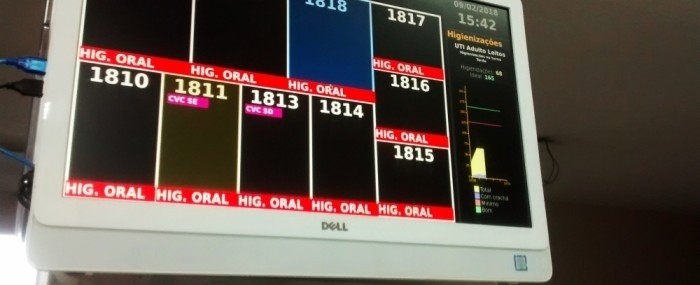
Monitoring of patient care procedures cuts hospital infection rates
20 de fevereiro de 2018By Suzel Tunes | FAPESP Research for Innovation – In 2017, ICU and Hospital Infection Control Service (SCHI) staff at the Santa Casa hospital in São Carlos, São Paulo State, Brazil, took several steps to reduce hospital-acquired infection rates. One such measure was the implementation of a patient care control system covering ten beds in an adult ICU run by SUS, the national health service. The system was developed by a local firm, i-Healthsys Produtos Médicos Ltda., with support from FAPESP’s Innovative Research in Small Business Program (PIPE).
The system monitors patient care and hand hygiene procedures, assisting medical and nursing staff with the implementation of good care practices. In five months, ventilator-associated pneumonia (VAP), one of the infections that most affect ICU patients in Brazil, fell more than 80%, from 46 to 8.8 cases per 1,000 ventilated patients per day. In the same period, there were no cases of catheter-related urinary tract infection, and the use of alcohol-based hand sanitizer increased more than 400%.
The fall in hospital-acquired infection rates yielded the additional advantage of cutting the length of ICU stays so that more patients could be admitted in the same period. “Bed availability rose approximately 40% compared with the corresponding period of 2016. From the public administration standpoint, this increase has a huge impact, enabling more ICU beds to be made available so as to provide better healthcare service in the city,” says the firm’s director Marcelo Prado, who has a PhD in mechanical engineering from the University of São Paulo’s São Carlos Engineering School (EESC-USP).
i-Healthsys developed the system using technology available since 2013, in partnership with a private referral hospital in São Paulo City. “We opted for Zigbee, a wireless data solution that’s more cost-effective than WiFi,” Prado explains. Sensors are fitted to the badges worn by medical staff and to patients’ beds and hand sanitizer dispensers. When staff approach the bed, a red light goes on to remind them to wash their hands. The light switches to green when they use the sanitizer.
A system linking 20 beds in the ICU of the São Paulo hospital was installed between October and December 2013. According to Prado, hospital-acquired infection rates were already very low there, and the hospital measured the system’s efficacy by the volume of hand sanitizer used in the ICU. “We calculated a rise of 50% in the volume of sanitizer used in the facility,” he says.
In 2014, the hospital decided to extend the system to 85 ICU beds and to patent the technology together with i-Healthsys in Brazil and the US. “Our system achieves 92% success in the control of hygiene procedures,” Prado says.
The tests produced additional knowledge about ICU patient care routines and revealed the need for a more comprehensive hospital infection surveillance system covering other care procedures. From this insight, the project selected by PIPE in 2016 was born. “The monitoring system can be used to manage a range of medical procedures, enhancing patient safety. It also facilitates access to information, permitting the issuance of reports and epidemiological studies,” Prado explains.
The system was then expanded to perform surveillance and control of procedures such as changing catheters and other invasive devices – the longer these stay in patients, the more likely they are to acquire an infection, Prado notes.
Catheters and tubes have an ID tag affixed to their packaging for monitoring purposes. A barcode reader can also be used. “When catheter use begins, the nurse simply places the tag against the sensor fitted to the bed to record the date and time of insertion. Length of use is then displayed on a monitor installed inside the ICU,” Prado says.
Another procedure the system can control is patient oral hygiene, which must be performed two or three times a day. “If oral hygiene isn’t properly done, before long, the patient may contract pneumonia, as the bacteria present in the mouth can lodge in the lungs,” Prado says. The system records the hygiene procedures performed and reminds health workers when the time comes to repeat them.
The system can also record information such as the number of times a patient is moved in bed, the medications administered and the time devoted to patient care by staff. “The tags can even be used to track people and equipment as they move about the hospital,” Prado explains. “The items to be controlled are defined in accordance with the needs of each hospital.” All this information remains available in real time in the ICU and can easily be viewed on a 23-inch screen installed in the nurses’ station.
Prado had previously received support from PIPE for the development of eye surgery simulation software.
Company: i-Healthsys Produtos Médicos Ltda
Site: i-healthsys.com
Tel: +55 16 2106-0234
Address: Rua Dr. Jonas Novaes, 669, São Carlos (SP), 13562-435, Brazil
Email: contato@i-healthsys.com.br
